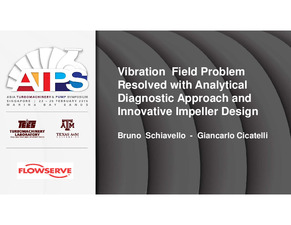| dc.contributor | Asia Turbomachinery & Pump Symposium (1st : 2016) | |
| dc.creator | Schiavello, Bruno | |
| dc.creator | Cicatelli, Giancarlo | |
| dc.date.accessioned | 2017-05-04T12:49:05Z | |
| dc.date.available | 2017-05-04T12:49:05Z | |
| dc.date.issued | 2016 | |
| dc.identifier.uri | https://hdl.handle.net/1969.1/160238 | |
| dc.description | Case Study | en |
| dc.description.abstract | Case Study 20: Several pumps of same design exhibited field vibrations above API limits, dominated by Vane Passage Frequency (VPF). Root cause analysis included both experimental and theoretical paths. Experimental investigation, with shop vibration tests and modal analysis, showed natural frequency of bearing housings at VPF. The theoretical approach, based on mainly hydraulic analysis, pointed out to discharge recirculation as primary cause of hydraulic excitation for high VPF vibrations. The solution was identified with the design of an innovative impeller geometry (5+9 vanes). Shop tests confirmed both overall performance and drastic reduction of vibrations below API limits. Pumps with the innovative impeller were installed in the field confirming reduction of vibrations. Lesson learned: high number of vanes at impeller outlet is a key feature for controlling hydraulic excitation forces, changing both VPF and amplitude. | en |
| dc.format.medium | Electronic | en |
| dc.format.mimetype | application/pdf | |
| dc.language | en | |
| dc.publisher | Turbomachinery Laboratories, Texas A&M Engineering Experiment Station | |
| dc.relation.ispartof | Asia Turbomachinery & Pump Symposium. 2016 Proceedings. | en |
| dc.subject.lcsh | Turbomachines | en |
| dc.subject.lcsh | Pumping machinery | en |
| dc.title | Vibration Field Problem Resolved with Analytical Diagnostic Approach and Innovative Impeller Design | en |
| dc.type.material | Text | en |
| dc.identifier.doi | https://doi.org/10.21423/R1SD76 | |


